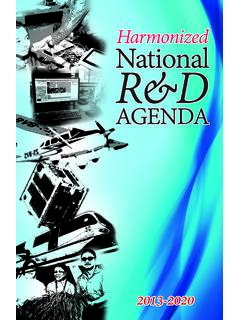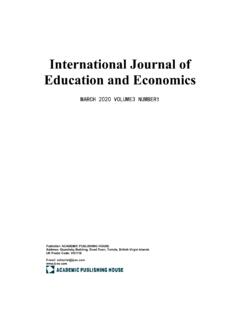Transcription of Effective Approaches to Poverty Reduction: Selected Cases ...
1 ASIAN DEVELOPMENT BANKNOVEMBER 2019 Effective Approaches TO Poverty REDUCTIONSELECTED Cases FROM THE ASIAN DEVELOPMENT BANKVOLUME 1 ASIAN DEVELOPMENT BANKNOVEMBER 2019 Effective Approaches TO Poverty REDUCTIONSELECTED Cases FROM THE ASIAN DEVELOPMENT BANKVOLUME 1 Creative Commons Attribution IGO license (CC BY IGO) 2019 Asian Development Bank6 ADB Avenue, mandaluyong City, 1550 metro manila, PhilippinesTel +63 2 8632 4444; Fax +63 2 8636 rights reserved. Published in 2019. ISBN 978-92-9261-872-8 (print), 978-92-9261-873-5 (electronic)Publication Stock No. TCS190535-2 DoI: The views expressed in this publication are those of the authors and do not necessarily reflect the views and policies of the Asian Development Bank (ADB) or its Board of Governors or the governments they represent.
2 ADB does not guarantee the accuracy of the data included in this publication and accepts no responsibility for any consequence of their use. The mention of specific companies or products of manufacturers does not imply that they are endorsed or recommended by ADB in preference to others of a similar nature that are not making any designation of or reference to a particular territory or geographic area, or by using the term country in this document, ADB does not intend to make any judgments as to the legal or other status of any territory or work is available under the Creative Commons Attribution IGo license (CC BY IGo) By using the content of this publication, you agree to be bound by the terms of this license.
3 For attribution, translations, adaptations, and permissions, please read the provisions and terms of use at # CC license does not apply to non-ADB copyright materials in this publication. If the material is attributed to another source, please contact the copyright owner or publisher of that source for permission to reproduce it. ADB cannot be held liable for any claims that arise as a result of your use of the contact if you have questions or comments with respect to content, or if you wish to obtain copyright permission for your intended use that does not fall within these terms, or for permission to use the ADB to ADB publications may be found at : In this publication, $ refers to United States design by Cleone Baradas.
4 Printed on recycled paperiiiCOntentstable and Boxes ivForeword vAcknowledgments viiAbbreviations viii1.
5 OvervIew 12. PrOvIdInG BrOAder ACCess tO eCOnOmIC OPPO rtunItIes Shanxi integrated agricultural development project 6 People s republic of dryland SuStainable agriculture project 11 People s republic of yunnan integrated road network development project 14 People s republic of Surkhandarya water Supply and Sanitation project 18 Uzbekistan3. PrOmOtInG resIlIenCe Food and nutrition Social welFare program and project 23 Social protection Support project 27 lower Secondary education For the moSt diSadvantaged regionS project 32 viet Nam4.
6 EmPOwerInG COmmunItIes thrOuGh ImPrOved GOvernAnCe Strengthening public management program 37 Small and medium-Sized enterpriSeS line oF credit project 43 Sri Lanka5. COnCludInG remArks 47 Bibliography 48ivtABle And BOxestable1 Preliminary Findings of the Pantawid Program Communities open Up to New Technology innovation Agriculture Support Lifts Family out of Poverty innovation The road to Better Business and Better opportunities innovation Improved Quality of Life Flows from New Water Supply innovation Changing the
7 System to Focus on the Poor innovation Cash Transfer Gives Poor Children in the Philippines a Chance innovation A Dream Fulfilled in the remote mountains innovation Increased Sustainable Development Capacity in Poverty -Stricken Area innovation From Aquariums to Fish Farms: Starting Small but Dreaming Big innovation 45vFOrewOrdThe story of modern Asia is the story of Poverty alleviation through economic growth. In a matter of decades, growth transformed a region defined by pervasive Poverty into the single most economically dynamic place on the planet.
8 Asia s remarkable success was driven by innovation and structural reform, and by a collaborative public sector that unleashed the dynamism of private sector solutions. And yet, although over a billion Asians have as a consequence emerged from extreme Poverty since 1990, much still remains to be done. more than 260 million people across the continent are today still mired in Poverty , and over 1 billion subsist on less than $ a day. It is the mission of the Asian Development Bank (ADB) to support the economic alleviation of the most vulnerable elements of society, and this volume presents nine specific examples of recent projects from our work that demonstrate Effective Approaches to Poverty reduction through innovative interventions.
9 Four of the projects (three from the People s republic of China and one from Uzbekistan) described herein expanded access to economic opportunity in order to ensure that those from poor and the disadvantaged backgrounds share in the gains from economic growth. Those from the People s republic of China were in sustainable agriculture, especially in dryland areas, as well as in the development of road networks in remote and poor regions. Higher crop productivity, improved market access for farmers, reduced travel time, and provision of safe and reliable water supply are just some of the benefits resulting from these interventions.
10 The other project from Uzbekistan improved provision of reliable, safe, and affordable water supply and sanitation services thereby raising the living standards of poorer of the projects highlighted in the book focus on the most vulnerable communities and promote resilience in specific population groups. These include a social protection scheme in the Philippines, a food and nutrition social welfare program in mongolia, and a lower secondary education project for the most disadvantaged regions of viet Nam. These projects bridge the Poverty gap by supporting beneficiaries as they cope with the shocks and crises that can arise from economic, social, financial, environmental, or climate change- related issues.


















